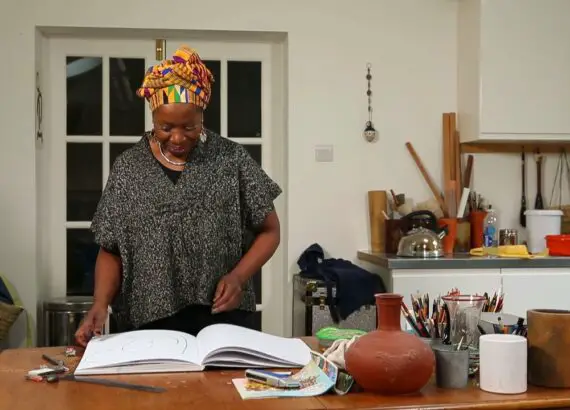What is Kintsugi Pottery? Repairing Broken Pottery with Gold
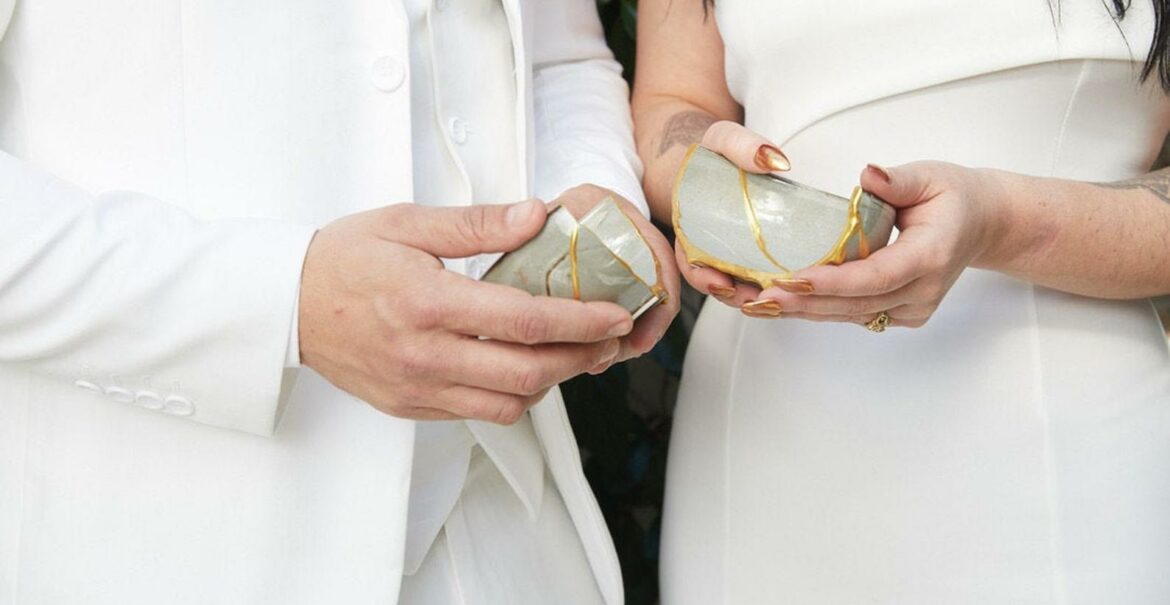
In the appreciation of beauty, many are of the philosophy that it is about finding the true beauty that lies within the object, despite any flaws it may possess.
This traditional Japanese philosophy is referred to as ‘wabi-sabi’. It translates roughly to the understanding that beauty is transient and should be appreciated despite its flaws.
There is, perhaps, nothing else that personifies this philosophy other than the Kintsugi art.
In the spirit of appreciating things despite their imperfections, kintsugi refers to the Japanese art of putting broken ceramic pieces back together with gold, silver, platinum, etc. mixed into a lacquer.
Table of Contents
History of Kintsugi Pottery
The Japanese word ‘kintsugi’, which translates to ‘golden joinery’, is a form of art that dates back over 400 years ago.
Some people believe that kintsugi pottery may have branched off from staple repairs, noting that the goal was to restore the function of broken ceramic pieces without obscuring the flaws.
The use of lacquer in Japan has always been a tradition, featuring as a form of glazing done on ceramics (a technique known as maki-e).
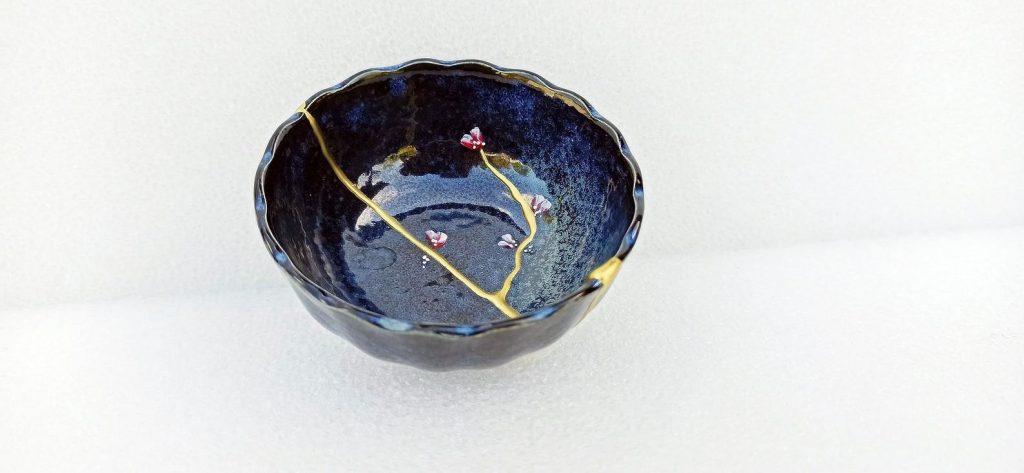
On the origin of kintsugi, a version of the legend has it that the art came about when the Japanese shogun, Ashikaga Yoshimasa sent a damaged tea bowl back to China where it was made, to be repaired.
When he received the finished products, he discovered that they had drilled holes around the broken edges, and used big metal staples and some glue to hold the pieces together.
He became deeply saddened by the fact that it would now function as a decorative piece, rather than a tea bowl, and ordered his best craftsmen in Japan to come up with something that would restore the tea bowl to its former glory.
Legend has it that after the craftsmen had finished their work, the result was so beautiful that some people were accused of deliberately breaking their valuable ceramics just so they could boast of such elegance that the kintsugi could bring. Thus, an elegant way of repairing broken pottery was developed.
Many kintsugi potters insist that their craft is mostly limited to pieces that are broken and not shattered, mostly because the process is a long and tasking one.
However, depending on the extent of damage done, the work could take anywhere from a week to two months
Philosophy of Kintsugi Art
In a time where imperfections are seen by members of society as something to hide, a lot can be learned from this humble Japanese art.
The driving philosophy behind kintsugi is that breakage in an artwork is something that should proudly display the art, and not something to hide.
Bearing more than a few similarities with the wabi-sabi philosophy, kintsugi aims at appreciating signs of use or wear in an object, and embracing it in a way that, even in its flawed state, its time of service does not end.
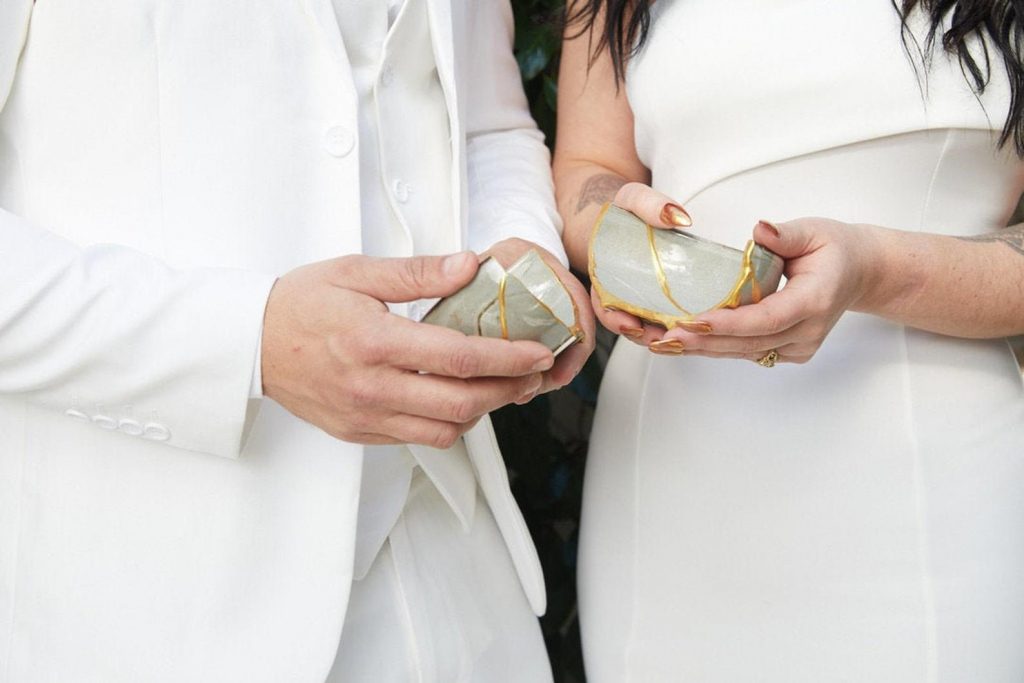
Kintsugi has a significant connection to a feeling the Japanese refer to as ‘mottanai’, which refers to regret that comes from the loss or damage of something precious.
It also relates to the Japanese philosophy of ‘mushin’, where transient objects are appreciated, even as time and chance happen to them. That, historians believe, was what the shogun, Yoshimasa felt when before and after he got the bowl back from China.
In essence, kintsugi encourages us to celebrate our imperfections, appreciating each scar as something that signifies the rigors of life we’ve been put through.
At a time when the world celebrates virility and pushes aside any crack in the façade, this philosophy has much to teach us.
Among others, this technique teaches us about resilience, and how our scars should be seen as marks to be proud of, rather than something to be ashamed of.
It is such a wonderful experience because it sets one on a journey of positivity, mindfulness, self-love, and appreciation, as well as helping us acknowledge our different battles and how we have come through them.
Methods Used In Kintsugi Pottery Creation
There is a lot more that goes into kintsugi than just whipping up a resin, sprinkling gold powder in it, and applying it on the cracked edges.
As a result of the multiple possibilities that could result from a break, kintsugi pottery is divided into three methods.
1. The Crack Method
This is the most common method employed in kintsugi pottery. It simply involves piecing together the broken pieces with the lacquer.
This method is possible because the pieces are readily available, and can be easily pieced back together. For example, the crack method was used to repair this red and black ceramic bowl.
2. The Fragment or Makienaoshi Method
This method comes in handy in the repair of objects that have had one or more parts missing, or completely shattered to the point that the pieces are too small to separate or use.
The parts with the missing fragments are covered completely with the lacquer, fashioned to fit the exact shape of the missing piece.
The fragment method was used to restore this functional vase from the Ahvah product line.
3. The Joint Method
This is the least common and most intensive method of kintsugi pottery creation. In this method, pieces from different ceramics are gotten and attached with the lacquer.
This method is the most tedious and longest to employ because one needs to first get pieces that fit together before any work is done. It is often paired with the fragment method if the pieces are not compatible.
The pieces do not have to be of the same color or design, so long as they fit.
Examples of Kintsugi Pottery
As versatile as pottery is, kintsugi pottery can be acquired and appreciated in many different forms, some of which are:
1. Kintsugi Pottery Bowls
Bearing in mind that each break mark is unique to each bowl, the trail of gold from the kintsugi repair would be unique. No doubt, this further deepens the level of uniqueness of each product.
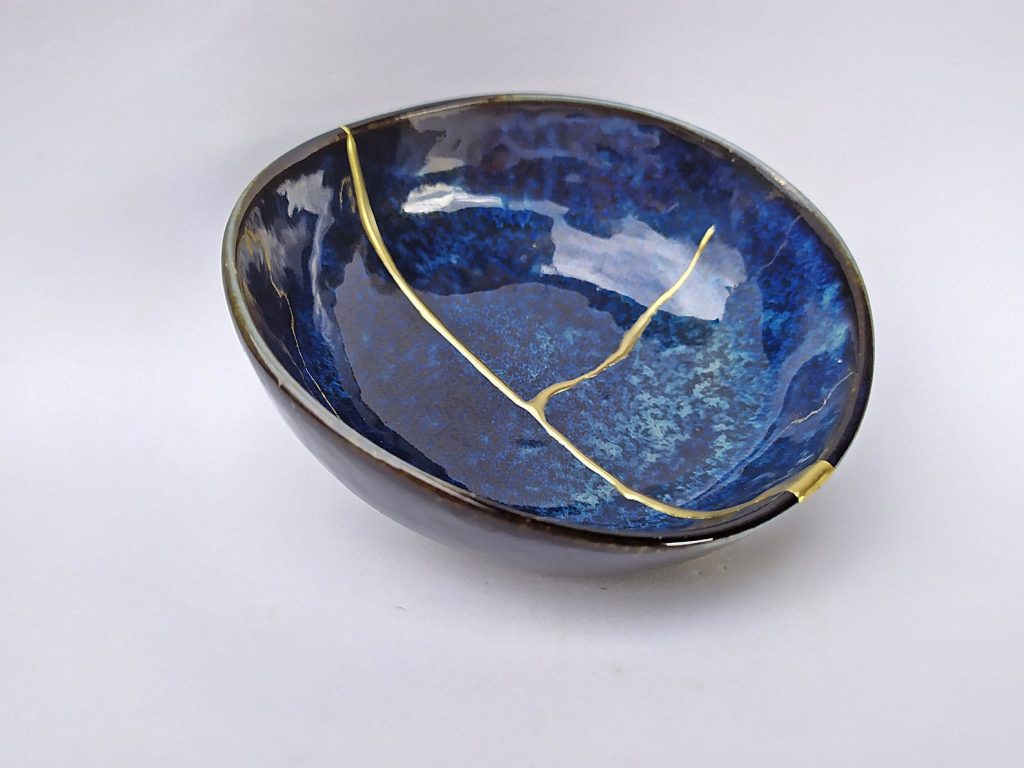
A perfect example of elegant kintsugi craftsmanship in bowl repair is this Empty Blue Decorative Kintsugi Bowl, a vibrant blue kintsugi bowl that has been put together so seamlessly and so beautifully that the contrast between the gold and blue colors seem to enhance the beauty and philosophy behind the creation.
Also, this very elegant Black & Gold Kintsugi Omnipotence Bowl just oozes opulence and beauty as each color balances and enhances the other.
2. Kintsugi Pottery Vases
The use of kintsugi on broken vases is as precise and thorough as it comes. Vases in particular take longer to repair than other pieces of pottery.
For example, this amazing Kintsugi Pottery Vase took roughly a month to repair, and the finished product is so unique and beautiful and would be even more cherished now.
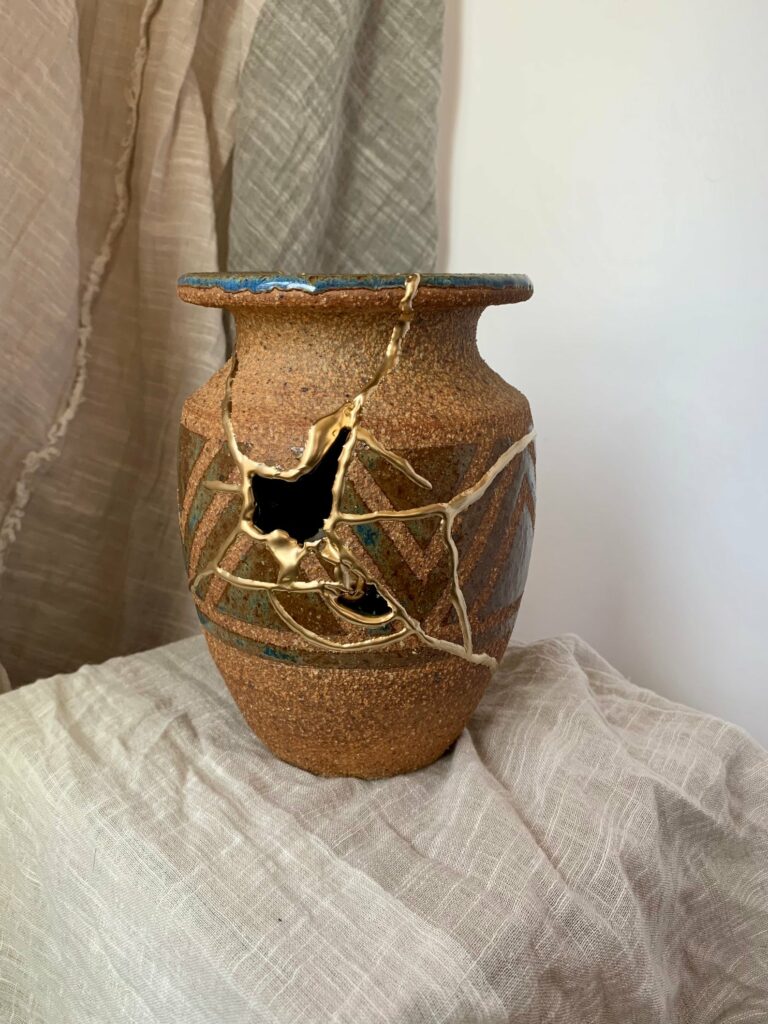
Also, this Kintsugi Vase is a perfect memoir to portray how significant one’s unique struggles have influenced them. The intricate trail of gold dust seems to perfectly highlight the underlying brown tone, giving the finished work an almost ethereal feel.
Justifiably, some people discourage the use of rejoined pottery pieces as dishes or bowls for serving food, but rejoined vases are known to have been enhanced to ensure safe use in any of such functions.
For example, this Kintsugi Vase has been covered with several layers of glaze to preserve its water-retaining abilities.
3. Kintsugi Pottery Mugs
Many times, we find ourselves developing sentiments for/ around some items we use daily, and we would be unwilling to let them go if they bear the signs of wear and tear.
Sometimes, owners of precious mugs often seek kintsugi repairs -no matter how expensive- to be able to have their belongings back.
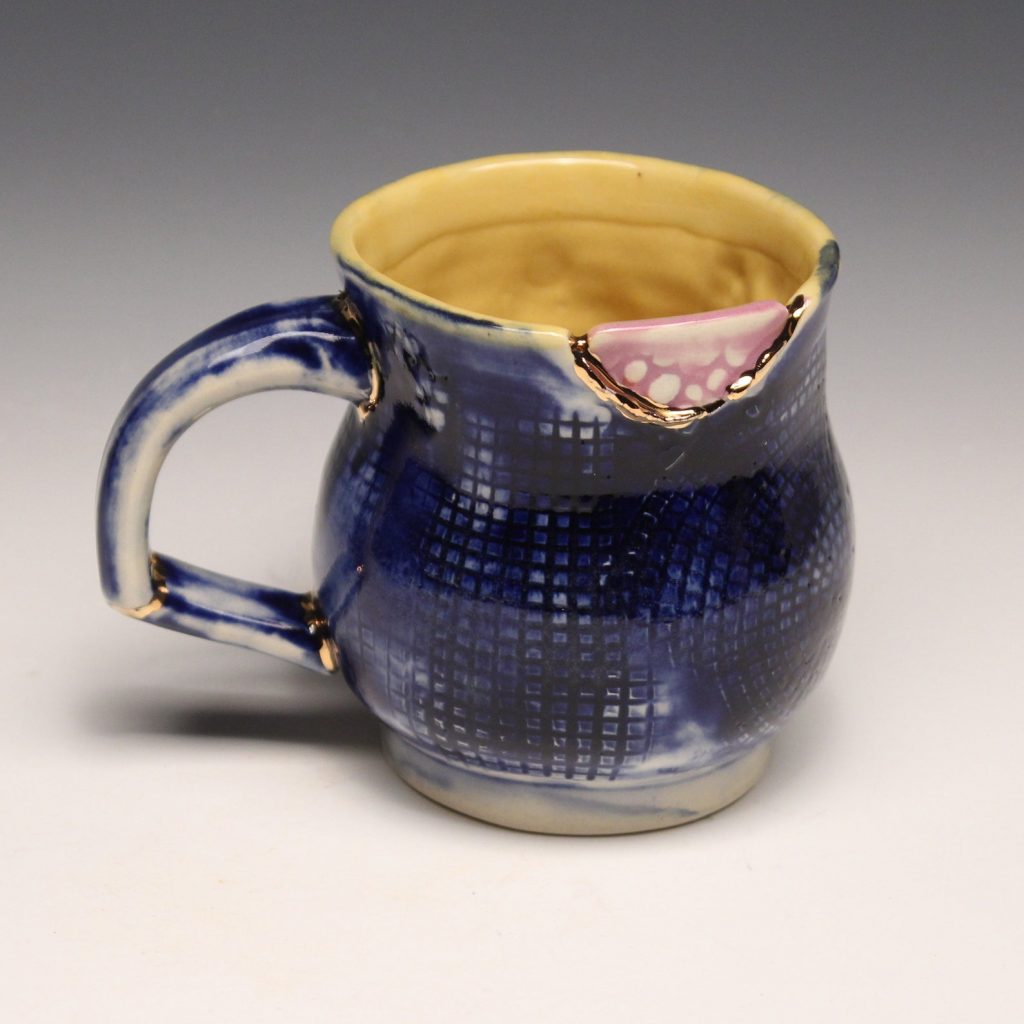
Other times, like is the case of this Kintsugi Mug – / Porcelaine & or fin by Seletti, pieces from different broken pieces are put together to form a whole new and unique pottery. For example, this particular mug is an aggregated finished product that contains parts from different similar objects, creating a patchwork pattern.
Speaking of a patchwork pattern, this Classic Mug from Redbubble combines different bright hues and colors to create a perfectly put-together mug.
Gone are the days where kintsugi mugs could only function as ornamental pieces; this mug was rejoined with functionality in mind. So whether it’s tea, coffee, or as a decorative piece, this eye-catcher does the job.
Some other forms of kintsugi pottery are trinkets and jewelry, ornamental plates and cups, wedding rings, ceramic toys, etc.
Gone are the days of tossing well-loved pieces of pottery because of cracks and breaks. Now, all you need are some lacquer (epoxy resin or any suitable adhesive would do), some clean sticks to mix the lacquer and gold, a brush for the final touches, the broken pieces, and some consistency.
Disclaimer: As a rule of thumb, potteries that have been rejoined with kintsugi should not be subjected to temperatures exceeding 32°C, unless the rejoining was done by a kintsugi expert.

